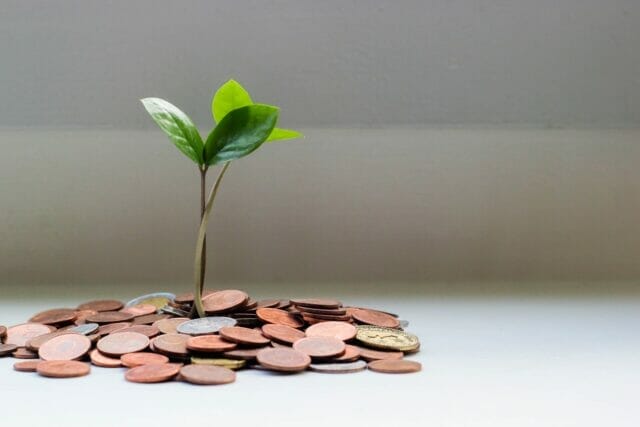One thing we’re leaving behind in 2025? Unethical bank accounts.
Climate change continues to be a growing issue, and we should all be committed to doing everything we can to turn that around. One (truly) easy change we can all make? Prioritizing ethical practice when it comes to our finances by opening an account with a green bank.
As a writer here at Eco-Stylist, I’m here to help you learn more about sustainable banking. The questions below were answered through my own research and with the help of Peter Hellwig, co-founder of ATMOS Financial, who was kind enough to further discuss green banking with me.

What is green banking?
Sustainable banking is exactly what it sounds like: a socially and environmentally-conscious alternative to the traditional method of banking we all know.
Unlike traditional banking, which aims to profit at all costs, green banking aims to address climate change. Some sustainable banks also have additional goals, like serving low-income communities or investing in toxin-free agriculture. Overall, community wellbeing is a major concern of green banking.
What role does banking play in climate change?
Great question, and the answer is related to the way banks make a profit.
When you deposit money into a bank, the bank then loans that money out to different companies (or to different people and projects). As loans are paid off, interest is also paid, creating a profit for the bank. Because it benefits banks to earn as much interest as possible, banks aiming to “profit at all costs” will often loan money to the oil and gas industry without any concern for the impact those companies have on the environment. In the past five years alone, banks have invested $2.7 trillion dollars into fossil fuels, directly funding climate change.
And how does this relate to you and me? The money banks loan out belongs to us. Chances are good that your bank is using the money you put in your savings account to contribute to climate change.

How does green banking work?
Sustainable banks operate in a way similar to traditional banks. They lend money to companies who then pay back the loan with interest. The difference? Green banks only lend money to companies in sectors that don’t contribute to climate change.
Not only do sustainable banks “divest,” or withhold funding companies with harmful goals and business practices, they also actively invest in companies that are aiming to make a difference in the world.
In other words, green banks are picky. They only support the survival of businesses that are making a positive impact in their communities and the world at large.
Why is sustainable banking important?
In our conversation, Pete summarized the answer to this question well: Sustainable banking is an important step of “aligning every part of your life to make the biggest impact.”
By choosing to open an account with a sustainable bank instead of a traditional bank, you’re ensuring your money is only being used to support sectors that positively influence both humans and the environment.
While a portion of each dollar you put into a traditional bank may be used to support the oil and gas industry, each dollar you put into a sustainable bank is used to support things like renewable energy and carbon offsets. Not only are you withdrawing support from unsustainable banking practices, you’re actively using your money to create positive change in the world.

Which banks are bad for the environment?
Most of the well-known mega-banks in America have a severely negative impact on the environment. Think Wells Fargo, Citibank, and Bank of America–they all play a major role in financing fossil fuels. According to research, JPMorgan Chase is actually the worst when it comes to funding both fossil fuels and the expansion of Arctic drilling and oil and gas extraction.
Keep in mind, just by having an account with these banks, you’re supporting unethical practice, whether you realize it or not. If you’d like to change this, the best thing you can do is find somewhere else to bank.
Guide to green banks 2025
You can probably guess what we’re going to say–signing up for an account with a green bank is a great first step. While there are differences between sustainable banks, they’re all better than traditional banking.
Pete’s advice: “Only bite off what you can chew, and don’t make it more of a task than it has to be.” Start out by simply signing up for a savings account.
If you feel overwhelmed, take it step by step. You don’t have to do everything all at once.
Here are two great green banks that we recommend:
Alternative option: cashback rewards for making sustainable choices
Eco-Stylist is reader supported. When you shop through links on our site, we may earn a commission. Learn more here.
In addition to making a positive impact with your savings, you can also make an impact with your spending! Our recommendation: The FutureCard.
FutureCard gives you cashback rewards and savings for making everyday positive choices like thrifting, choosing clean energy for your energy bill, spending on public transportation, EV charging, and a whole lot more!
Beyond banking, you’ll also want to make sure you’re making sustainable investments and spending your money wisely day-to-day. Learn more by reading Eco-Stylist’s article on sustainable money management.

Now, a question for you … are you ready to take the next step toward fighting climate change?
You know the basics of green banking, and you know what to do next: Ditch your bank. Take control of the way your money is used. Open an account with a bank that cares about the impact they have on the world around them.
If we all make this small change, it will have a big impact.
Here’s to an even more sustainable 2025!

Celia Wiseman studied Communication and Creative Writing at the University of Iowa, and her growing interest in sustainable living led her to Eco-Stylist. In her free time she enjoys reading, writing, and making videos, as well as any other activity that allows her to get creative.









